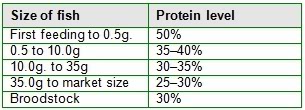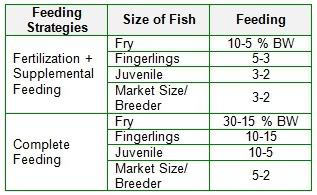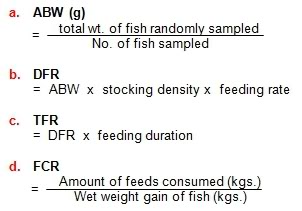Important points to be considered in feeding of tilapia
Feeding Habits
An understanding on the natural feeding of fish is important in order to produce:
1. An acceptable and nutritionally adequate diet.
2. A proper feeding regime is adopted to ensure optimal growth and survival of the fish

Tilapias are also daytime and surface feeder. It means they eat at the water surface and eat more during the day. At night there is little or no feeding activity.
Protein Requirement

Tilapias are able to utilize below the optimum and still produce good growth. The use of sub-optimal protein levels in tilapia feeds will lower feed costs and improve economics.
Forms/ Types of Feeds
1. Mash or powder form
This is given to fish weighing less than 0.2g. to 5.0g./pc. This is known as the fry mash
2. Crumbles
This is given to fish weighing 5.1g. to 30.0g./pc. This is also known as the starter crumble.
3. Pellets
This is given as soon as the mouth of fish is big enough to swallow the smallest size of pellet.
a. Juvenile Pellet. This is known as the grower pellet. It is given to fish weighing 30.1 to 90.0g./pc.
b. Adult Pellet. This is known as the finisher pellet. It is given to fish weighing greater than 90.0g./pc.
4. Dough or ball form
It is prepare by adding water to the feed while mixing until sticky mass is formed. In the absence of pelleting machine, feed maybe prepared in this manner.
Pellet Size
Tilapias prefer smaller pellets and dislike hard pellets. As a rule of thumb, small fish should be provided with small feed particles while large fish should be provided with large feed particles.
Feeding Ratio
It is the amount of feed being fed daily to the fish. It is also expressed as percentage of fish biomass.

Feeding rates are affected by water temperature. Fish of all size eat less and stop taking feed as water decreases or increases beyond their optimum range.
Optimum production temperature is approximately 28 degree Celsius with a range between 25-30 degree Celsius.
Feeding Schedule
It refers to the specific time and frequency at which the feed allowance is given to the fish.

Tilapias are suited to deal with regular supplies of food or little and often.
Feeding Method
1. Hand feeding (Sabog)
Feed is distributed evenly or in several sites so that all fish have access to food.
2. Using feeding bag
Feed is placed in a B-net (32 mm mesh size) feeding bag and tied in poles. The bag is suspended in pond water surface. Fish obtain feeds by picking or suction.
Determination of Average Body Weight (ABW), Daily Feed Ration (DFR), Total Feed Requirement (TFR) and Feed Conversion Ratio (FCR)

The closer the FCR to 1.0 kg. The better is the feed. Good feeds have FCR’s of between 1.5 to 2.0 kg.
Pointers in Fish Feeding
1. Always feed the fish at the same time and in the same part of the pond. Fish will learn where to go to get their food.
2. Do not overfeed. Too much food will not be eaten but will decay and will use up oxygen during decaying process.
3. Monitoring the dissolved oxygen of the pond regularly. Ponds with low DO concentrations, fish will eat less and they will not convert food to flesh efficiency.
4. Do not feed the fish for about 24 hrs. before harvesting or transporting. When the fish eat, they void the waste into the water. Combination of food and wastes makes the water turbid and increases the stress that is already placed on fish by the breeding and harvesting process.
5. Always have routinary pond cleaning and stock inventory. Aquatic macrophytes remove inorganic nutrients and limit phytoplankton growth.
6. Keep daily records of feeds given and of fish mortality. It would determine the efficiency of a feeding program and would help one to interpret if the business was successful or not.
7. Avoid overstocking the pond. It deteriorates water quality, increase metabolic waste build up and lead to poor utilization of supplemental feeds.
For more information please call or write to:
The Project Manager
BFAR-NFFTC
CLSU, Muñoz, Nueva Ecija
Tele-Fax no. (044) 4560-670
E-mail address: [email protected]
Source: nfrdi.da.gov.ph


Tilapias are also active throughout the day and eat on the surface. It indicates that they feed near the water’s surface and consume more calories during the day. There is little or no feeding activity at night. Thank you!
Dear,
I am an owner of small Fish Cage Farm in Lake Buhi.
I intend to produce my own Feeds /Pellets for my Fish Farm.
Kindly provide me more information on sustainable and eco -friendly Feeds /Pellets .
Thanks you.
Regards,
Dionisio
thank you so much for this information…. this is a very big help to students like me… hope you will post more
We are also planning to raise bangus, crabs and prawns (hipon) altogether in a pond, can you please share informations on these?, thanks.
How do you get the weight of Tilapia w/o necessarily taking it to determine the kind of feed and frequency of feeding? How can we determine when to change/shift the type of feed w/o necessarily considering the weight? Can we do it by counting the no of dayys?